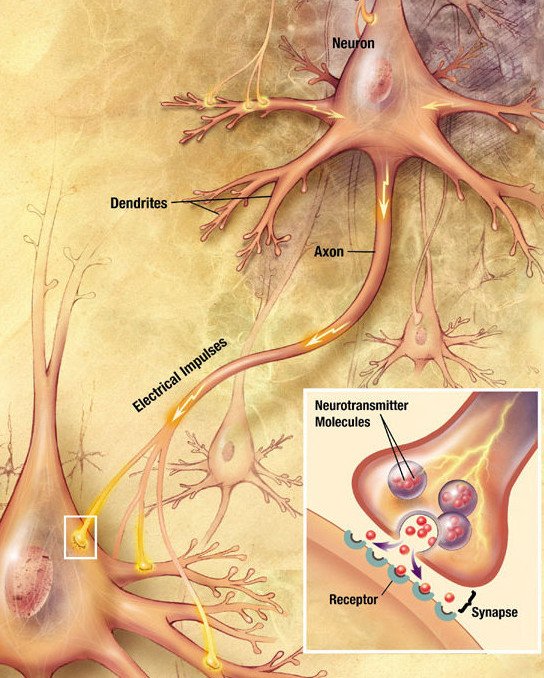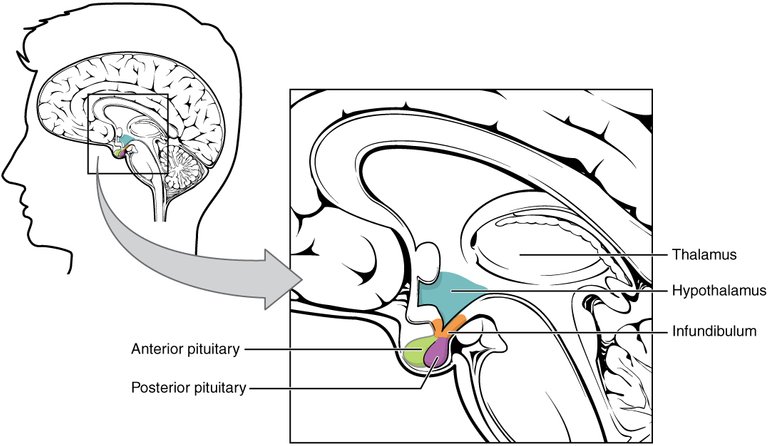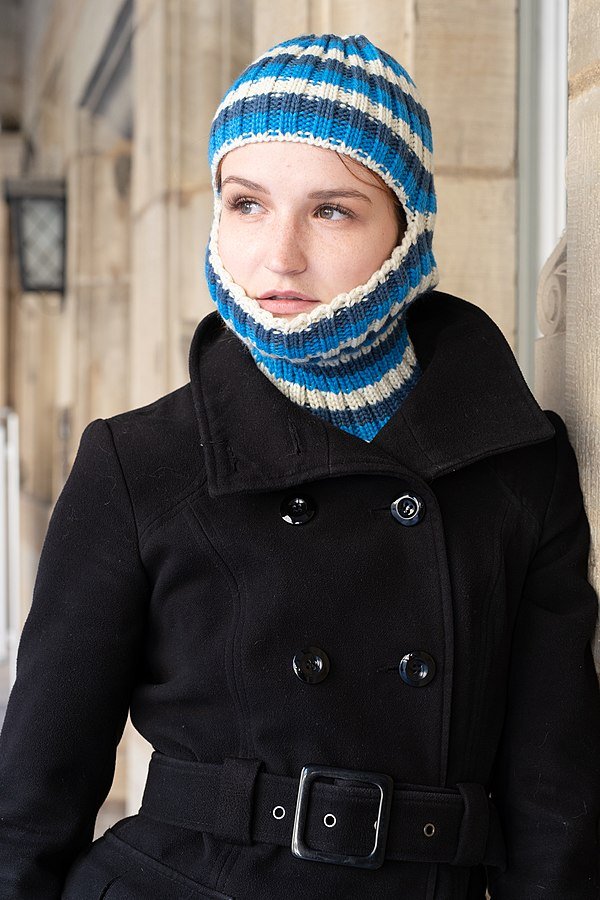
Temperature regulation.
source: Wikipedia Author: openstax collage, CC Attribute 3.0 Unported
You might have wondered how some mechanisms in your internal environment are being regulated and controlled. Have you tried to comprehend how your body tackles any changes in your internal environment? Let's say that your body temperature suddenly gets higher while doing exercise and after, withdrew to your normal temperature, you would ask yourself what does that work of regulating temperature of your body.There's no magic in that! What coordinate this regulation is your nervous system and endocrine. Hence, the neural system work with the endocrine system to communicate, integrate and coordinate in order to regulate the internal body and also help the body to respond to both internal and external changes!
First, what is regulation of internal environment or body? regulation of internal environment or body means balancing or maintaining a steady state by self regulation in order to create fairly constant environment in an organisms.
All living organism must conserve their internal environment for normal and efficient functioning of the body cells.
The internal environment refers to the internal setting in which the body fluids such as( blood, semen, vaginal secretion, cerebrospinal fluid, synovial fluid, pleural fluid, pericardial fluid, peritoneal, amniotic fluid, breast milk, nasal fluid, saliva gastric) occurs. This internal environment must be kept constant for the normal, healthy and adequate functioning of the body cell.
Organisms, both unicellular and multicellular organisms must be proficient to regulate any changes in their physical and chemical conditions of its body fluids. They must be able to maintain internal body conditions even when the external environment changes. These changes can be change of pH, temperature, salt level, water levels glucose levels, osmotic pressure, concentration of dissolved substance in the body fluid such as carbon dioxide, oxygen, urea, food substance examples; Amino Acids, and minerals ions such as sodium, potassium, chloride etc.
Unicellular organisms like Amoeba and Paramecium have mechanisms for conserving their internal environment. For example, Paramecium acquires contractile vacuole which enables them to carry out internal body regulation!
Paramecium contractile vacuole
source:Wikipedia Author: derivative work: Hämbörger (talk), CC BY-SA 3.0
Cell content of these unicellular organisms is hypertonic to the external environments hence water penetrate them via osmosis into their body and then into the contractile vacuole. In order to avoid the cell from being accumulated or turgid and bursting, the contractile vacuole expels it's contents frequently thereby, maintaining water balance with the organism.
The multicellular organisms have a sufficient ways of maintaining their internal body environment. The cell of multicellular organisms become specialized for particular task and communicate with one another to maintain their internal environment. Higher organisms posses specialized organs in the body which are involved in regulation of internal environment. The organs have made regulation of internal environment in multicellular to be efficient. Various organs in the body are involved in maintaining the internal environment, these constitute the lung, pancreas, kidney and skin.
For these organs to function properly, they must coordinate with nervous and endocrine system. Nervous and endocrine systems exert the ultimate control in the maintaining of internal environment. When the endocrine and nervous system detect changes in either the internal or external environment, they quickly respond to those changes by sending out a signal to stop the response through the help of a control system called "Negative feedback". The control system have three interdependent components; a sensor, the integrating Center and an affector. 
Synaptic transmission in neurons
source: Wikipedia Author: US National Institutes of Health,Title 17, Chapter 1, Section 105 of the US Code
Let me quickly explain how these three control mechanism work. When the sensor in the cell detect information such as changes in the internal or external environment, through receptors on their surface, they transmit this information via nerves from the sensory cells to the integrating Center. The information detects is being initiates by mostly the hypothalamus, region of the brain. through motor neurons, the impulse is transmits away from the integrating Center to the effector organ which can be kidney skin etc.
You can agree with me that regulation of internal body will not be efficient without the help of the nervous and endocrine systems. All the specialized organs in the body depend on the nervous and endocrine system to carry out their functions effectively.
Now, let's explore more deeply on how the skin of mammals regulate their body temperature. Mammals are homeothermic animals. Homeothemic means animals that have a constant persistent body temperature that is independent of the temperature of it's environment. Mammalians skin regulates body temperature with it's blood supply. Different individual have their own normal body temperature which can be higher or lower. Regardless of the changes in the temperature, mammals constantly adapt their temperature to environmental conditions. Mammalians temperature is being regulated by the part of the brain called the hypothalamus.
This is what happens on a hot day or temperature, the sensor nerves in the skin receive stimuli from external surroundings and send them to the hypothalamus for interpretation and action.

The Hypothalamus
source: Wikipedia Author: OpenStax College, CC by 3.0
A very large volume of blood will flow to the surface of the skin when the capillaries near the skin surface dilate, while those in deeper layers of the skin constrict, this heat is lost via conduction, convention and radiation to the surrounding. The sweating glands will become active and stimulate large amount of sweat that flow to the surface of the skin. Vaporization of the sweat on the surface of the skin help in cooling the body. The metabolic reactions in the body is reduce and activities of the body is slow down, hair erector muscles relax making the hair on the surface of the skin to lie flat, forcing the trapped hairs out. People do wear light clothes with light colored absorbent material to keep cool
On a cold day or weather, nervous sent impulse to muscles to generate extra metabolic heat via shivering, the capillaries near the skin surface constrict, while those in deeper layers dilate and this cause small volume of blood to flow to the surface of skin. The metabolic rate of the body is increase so as to produce more heat, the hair erectors contract to rise the hairs and trap air. Air is a bad conductor of heat and acts as an insulator thus preventing heat loss. Heat loss can also be prevented by behavioural changes, for instance, wearing wollon clothes, coat or keeping warm near a fire via radiation.
She wore coat for protection against cold
source: Wikipedia Author:Tobias ToMar Maier,CC BY SA 3.0.
Skin is very important in regulating body temperature. some factors can make your skin not to regulate body temperature effectively.
Sometimes your body temperature may fail to be regulated and this happens when the hypothalamus isn't functioning properly.
Dysfunction of the hypothalamus Will cause inability to control temperature and this results to thermoregulatory dysfunction,a situation in which exaggerated or abnormal changes in the body temperature occur spontaneously or in response to environmental or internal stimuli.
so for your internal body to be regulated efficiently, your hypothalamus must be functioning effectively!!
References:
[1] Why do we need to maintain a constant internal environment? - OCR 21C
[2] How do your brain regulates your body on a cold weather
[3] How skin control body temperature
[4] Organ system involved in homeostasis
[5] Homeostasis and cells
[6] Sensory cell
[7] Homoiothermhic Animals
[8] Impaired thermoregulation
@tipu curate
I'm very much grateful for your support
Upvoted 👌 (Mana: 6/12)
The pituitary glands are remarkable little peanuts! They play such an important role that so many are unaware of. Looks like you learned quite a bit with this one.
Yes pituitary glands are the master glad. They also control other glands in the body. Glands are very much vital in our body activities.. I will do more research on hormones!...Yes this was my first assignment at high school then.
thank you for always having my back.🙏🙏🙌
Thanks for your contribution to the STEMsocial community. Feel free to join us on discord to get to know the rest of us!
Please consider supporting our funding proposal, approving our witness (@stem.witness) or delegating to the @stemsocial account (for some ROI).
Thanks for including @stemsocial as a beneficiary, which gives you stronger support. Using the STEMsocial app could yield even more supporti next time.
Congratulations @jsalvage! You have completed the following achievement on the Hive blockchain and have been rewarded with new badge(s) :
You can view your badges on your board And compare to others on the Ranking
If you no longer want to receive notifications, reply to this comment with the word
STOPTo support your work, I also upvoted your post!
Do not miss the last post from @hivebuzz:
Support the HiveBuzz project. Vote for our proposal!
@jsalvage: Nice post and congrats for getting stemsocial vote. But remember that you need to interact with comments to your article too. :) Best wishes!
@dexterdev! Thank you for taking the time to help me, it really meant a lot.
its your hardwork. you deserve it....
Thanks for giving brief insight about temperature regulation of body. We are promoting, technology, science, coding and programming posts.
Your post has been submitted to be manually curated by @gitplait community account because this is the kind of publications we like to see in our community.
Join our Community on Hive and Chat with us on Discord.
[Gitplait-Team]
I'm glady you read my post. Thanks very much
The hypothalamus remains the grandmaster of temperature regulation...
The human body is such a complex system that has been well studied over the years.
Thank you for sharing such an interesting and educative article
Yes that's true. I'm glady you find this article interesting